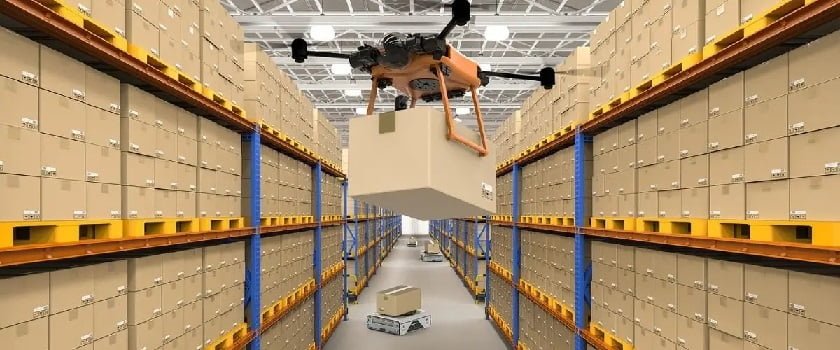In today’s fast-paced, e-commerce-driven world, warehouses face increasing demands for efficiency, accuracy, and speed. As businesses strive to meet these challenges, robotics have emerged as a transformative force in warehouse management. The integration of robotic systems into warehouses is not just a trend but a strategic move to enhance operational capabilities and unlock new potential. This piece goes into detail about the many ways that robotic systems can help in warehouses and how they can completely change how logistics and the supply chain work.
Enhanced Efficiency And Productivity
Increasing speed and productivity is one of the best things about using robotics warehouse. Robots are capable of performing repetitive and labor-intensive tasks with precision and speed, which significantly reduces the time required to complete these tasks. Picking, packing, sorting, and palletizing are all jobs that automated systems can do more accurately and faster than people. This increased efficiency translates to faster order fulfillment, which is crucial in meeting the growing expectations of consumers for quick and accurate deliveries.
Robotic systems, like Automated Guided Vehicles (AGVs) and Autonomous Mobile Robots (AMRs), make it easier for things to move around in the warehouse. These robots can navigate complex warehouse layouts, transport items from one location to another, and even deliver products to picking stations, all without human intervention. By automating these processes, warehouses can optimize their workflows and reduce bottlenecks, leading to smoother and more efficient operations.
Improved Accuracy And Reduced Errors
Accuracy is critical in warehouse operations, where even minor errors can lead to significant disruptions and customer dissatisfaction. Robotic systems excel in precision, minimizing the likelihood of errors that are common in manual handling. Robots that are very advanced have very complex sensors and vision systems that let them find things and accurately handle them. This technology reduces the risk of mispicks, misplaced items, and inventory discrepancies.
Moreover, the use of robotics reduces the chances of human error, which is particularly important in high-volume and high-pressure environments. By automating repetitive tasks, warehouses can ensure that products are picked, packed, and shipped correctly, enhancing overall inventory accuracy and customer satisfaction.
Increased Safety And Reduced Labor Costs
The warehouse environment is often fraught with hazards, from heavy lifting to high-speed machinery. Robotics play a crucial role in improving workplace safety by taking on dangerous and physically demanding tasks. For instance, robots can handle heavy lifting, reducing the risk of injury to human workers. This shift not only enhances the safety of employees but also lowers the number of workplace accidents and associated costs.
Additionally, robotics can help address labor shortages and reduce labor costs. With the increasing difficulty of finding and retaining skilled warehouse workers, automation provides a viable solution. Robotic systems can operate around the clock, eliminating the need for shifts and overtime and reducing overall labor expenses. It can be expensive to buy robots at first, but the money you save on labor costs and the higher return on your investment usually more than cover these costs.
Scalability And Flexibility
Scalability is another significant benefit of incorporating robotics into warehouse operations. Because robotic systems are flexible, companies can easily scale up or down as needed as demand changes. Automated systems can be easily reconfigured or expanded to accommodate changing needs, such as increased order volumes during peak seasons.
Robotic solutions can also adapt to various types of products and packaging requirements. Robotic arms with different end-effectors, for example, can move a lot of different things, from small packages to big boxes. This versatility ensures that warehouses can manage diverse inventories and adjust their processes to meet evolving market demands.
Data-Driven Insights And Optimization
Robotic systems generate valuable data that can be leveraged for further optimization of warehouse operations. Advanced robotics come equipped with sensors and analytics capabilities that provide real-time information on inventory levels, workflow efficiency, and equipment performance. You can look at this data to find trends, predict demand, and get the most out of your inventory management.
By utilizing data-driven insights, warehouses can make informed decisions to enhance their operations. For example, predictive analytics can help anticipate maintenance needs, reduce downtime, and improve overall equipment reliability. Furthermore, data-driven optimization can lead to more accurate demand forecasting, better inventory control, and improved supply chain management.
Conclusion
The integration of robotic systems in warehousing represents a paradigm shift in how logistics and supply chain operations are managed. By enhancing efficiency, accuracy, safety, and scalability, robotics unlock the full potential of warehouse operations. As technology continues to advance, the capabilities of robotic systems are likely to expand, offering even greater benefits and opportunities for innovation. Embracing robotics in warehousing is not just a technological upgrade but a strategic move towards achieving operational excellence and staying competitive in the ever-evolving market landscape.



